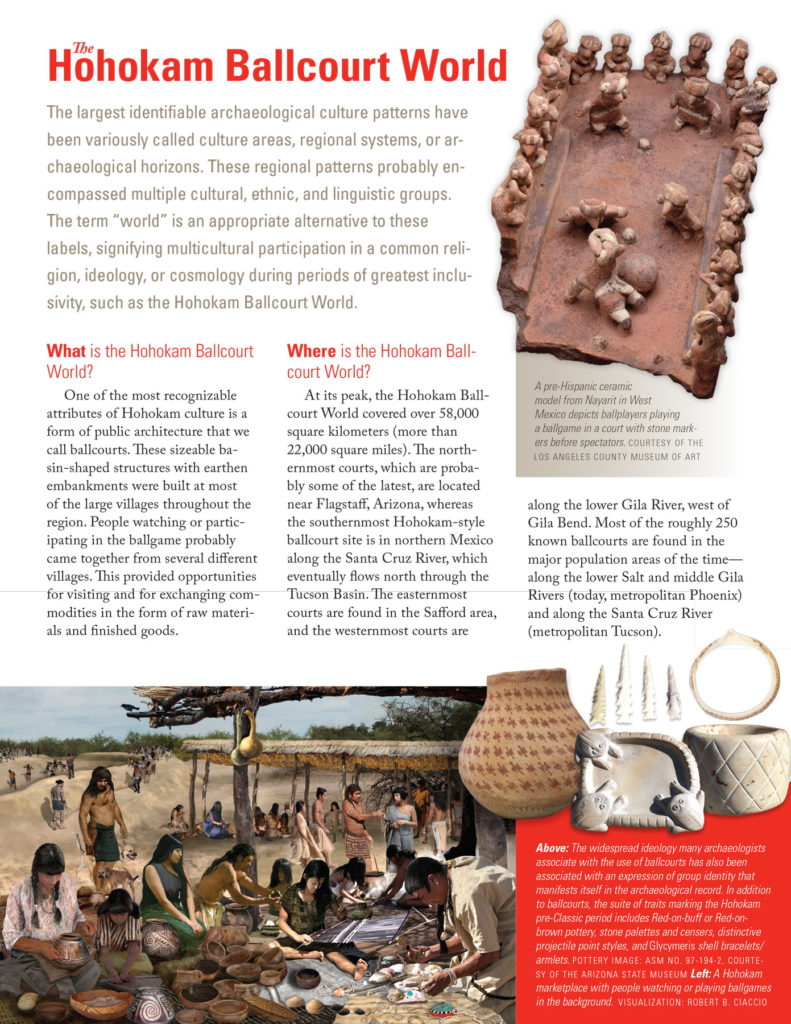
The largest identifiable archaeological culture patterns have been variously called culture areas, regional systems, or archaeological horizons. These regional patterns probably encompassed multiple cultural, ethnic, and linguistic groups. The term “world” is an appropriate alternative to these labels, signifying multicultural participation in a common religion, ideology, or cosmology during periods of greatest inclusivity, such as the Hohokam Ballcourt World.
What is the Hohokam Ballcourt World?
One of the most recognizable attributes of Hohokam culture is a form of public architecture that we call ballcourts. These sizeable basin-shaped structures with earthen embankments were built at most of the large villages throughout the region. People watching or participating in the ballgame probably came together from several different villages. This provided opportunities for visiting and for exchanging commodities in the form of raw materials and finished goods.
Where is the Hohokam Ballcourt World?
At its peak, the Hohokam Ballcourt World covered over 58,000 square kilometers (more than 22,000 square miles). The northernmost courts, which are probably some of the latest, are located near Flagstaff, Arizona, whereas the southernmost Hohokam-style ballcourt site is in northern Mexico along the Santa Cruz River, which eventually flows north through the Tucson Basin. The easternmost courts are found in the Safford area, and the westernmost courts are along the lower Gila River, west of Gila Bend. Most of the roughly 250 known ballcourts are found in the major population areas of the time—along the lower Salt and middle Gila Rivers (today, metropolitan Phoenix) and along the Santa Cruz River (metropolitan Tucson).
When did the Hohokam Ballcourt World flourish?
Ballcourts began to appear in the Hohokam World around A.D. 750 and, with a few exceptions, were not used past A.D. 1075. Ballcourts in the Flagstaff area were made and used much later than those in the southern Southwest. For example, people used the court at Wupatki from around A.D. 1100 to 1215.
How do we know these structures were ballcourts?
Early archaeologists believed that these structures were reservoirs. When excavated, though, they showed no evidence of water-deposited sediments—no fine layers of silts and clays that would have settled to the bottom of standing water. Instead, archaeologists found smoothed or plastered surfaces (or both) and “centerline markers” similar to those seen in Mesoamerican ballcourts, which had been documented in 16th-century Spanish accounts.
What new research is underway in the Hohokam Ballcourt World?
Thanks in large part to over 50 years’ worth of legally mandated projects, an enormous amount of archaeological fieldwork has been conducted within the Hohokam Ballcourt World. Aspects such as chronology and settlement patterns are well established, allowing researchers to delve into large anthropological issues at a regional scale.
Part of Archaeology Southwest’s new research on social identity (how people saw themselves and expressed that relative to others) across the Gila River watershed focuses on the Hohokam Ballcourt World. The “World” concept helps us think about shared identity and behaviors, but we also want to explore diversity and variability within the Hohokam Ballcourt World. Looking at local networks and social boundaries within the Ballcourt World will allow us to investigate group identity at multiple scales—from village identity to multi-village community to the entire Ballcourt World—to determine when identity was more persistent (when people resisted change and new ideas) and when it was more fluid (when people embraced change and new ideas). It will also allow us to explore patterns at the edges of the Ballcourt World, as in the Lower Gila region.
This research provides new information about the Hohokam Ballcourt World, while also compiling and synthesizing old data to offer new insights into the ways that groups of people form social boundaries.
Want to learn more? Explore the major concepts, places, cultures, and themes that Southwestern archaeologists are investigating today in our Introduction to Southwestern Archaeology.